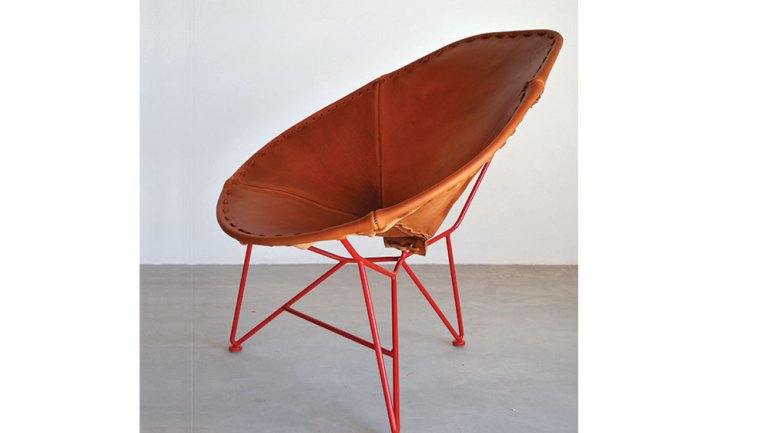High-Plains Classic
High-Plains Classic
Inspiration often comes from surprising places. For artist Jamey Garza, it came from a pair of weathered Acapulco chairs he had in his backyard. Garza, with Constance Holt Garza, his design partner and wife, took the skeleton of a classic, mass-produced 1950s beach chair and made it his own by moving it indoors and upholstering it in quarter-inch saddle-grade leather, suspended in low-slung buckets over a steel rod frame. The result is an artful reflection of the rugged West Texas cattle-ranching culture that permeates the couple’s art-centric hometown of Marfa, Texas.
Garza did metal fabrication and built custom fixtures and furniture for art galleries and other commercial clients for more than 20 years before debuting his Garza Furniture line in 2012 at Heath Ceramics in Los Angeles and San Francisco.
“We like to think that the line conveys a sense of the high-plains Texas desert where it was born,” says the 49-year-old Garza, who has also been influenced by Donald Judd, the minimalist sculptor who split his time between New York and Marfa in his last 40 years, and played a major role in transforming the remote outpost – population 2,000 – into the international art destination that it is today.
Garza Furniture’s venture with Heath was so successful – and the two companies’ aesthetics so harmonious – that they collaborated on a special Heath/Garza tile-topped coffee table, Table No. 1. And Heath now carries the Garza Marfa line of furniture – which is also available at Totokaelo in Seattle and the Steven Alan Home Shop in New York.
“The detail of Jamey’s design is exquisite but not precious,” says trendsetting hotelier Liz Lambert, who hired Garza in 1998 to work on her groundbreaking re-do of the now-iconic Hotel San José in Austin. “Jamey was an integral part of the design of it.” Lambert credits Garza for the San José’s signature reclaimed pine bed platforms, desks, benches, and outdoor tables, as well as all of the custom metal work.
A native Texan, Garza enrolled at the University of Texas at Austin in 1982, with plans to become a graphic designer. But he ended up getting a BFA in painting, followed by an MFA from the San Francisco Art Institute in 1990. Focusing on his paintings at night, he worked by day as an “all-around facilities handyman” at the Headlands Center for the Arts in Sausalito. There, his interest in design, furniture, and architecture was piqued when he met San Francisco conceptual artist David Ireland and helped build installation artist Ann Hamilton’s Mess Hall renovation at the center.
In 1998, he moved to Los Angeles with Constance, where he continued to support his painting studio with his design/build skills. The duo enjoyed LA, but “always considered it a transition before coming back to Texas,” says Garza. So when Lambert called for help resurrecting Marfa’s Thunderbird Hotel in 2003, Jamey and Constance moved camp permanently to the fabled art mecca. In Marfa, they found themselves inspired by the large body of Donald Judd-designed furniture on display in various buildings around town.
But that’s not all: The vast, empty vistas and rustic isolation of Marfa, many miles from the nearest Starbucks, are easily seen in Garza’s unadorned style. Garza works with materials that are both local and durable, such as the native Texas woods of pecan, oak, and mesquite that form the tops of his stools, coffee tables/benches, and tables. Garza’s considerable skills with metal can be traced to his grandfather, who owned his own welding and radiator repair shop.
Today, the Garzas are putting the finishing touches on their new 900-square-foot studio/showroom near Marfa’s main drag, where they’re working out new designs and expanding their line to include canvas as an upholstery option.
With all the foreign art-tourists flocking to Marfa, it was just a matter of time before Garza Furniture went global. Next up: a collection of furniture for a hotel in Panama City.
Christina Patoski is a writer and photographer in Fort Worth, Texas.




